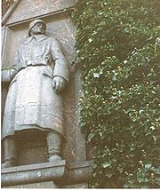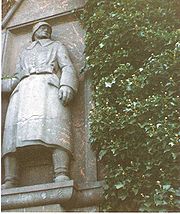
Georgsmarienhütte
Encyclopedia
Georgsmarienhütte is a town in the district of Osnabrück
, in Lower Saxony
, Germany
. It is situated in the Teutoburg Forest
, approx. 7 km south of Osnabrück
.
who supported industrial development, and his wife Marie
. The company was called Georgsmarienhütte. The workers’ housing estates grew and developed to the municipality Georgsmarienhütte. Malbergen became part of Georgsmarienhütte in 1937. In 1970, the municipalities Oesede, Kloster Oesede, Harderberg, Holsten-Mündrup, the southern part of Holzhausen and the "industrial village" Georgsmarienhütte were united to the city Georgsmarienhütte.
The iron and steel works were one of the most important employers south of Osnabrück, employing several thousand people. Since 1923 it belonged to Klöckner Werke AG which suffered severely from 1990's steel crises. In 1993, Klöckner manager Jürgen Großmann bought the steel works for a symbolic amount of money and transformed it to an efficient company which is one of the leading high grade steel producers in Europe.
 The most important historical building is the church of former convent Kloster Oesede dating from the 12th century. The Benedictine
The most important historical building is the church of former convent Kloster Oesede dating from the 12th century. The Benedictine
convent was founded by count Ludolf von Oesede (d. 1184) and his wife Thedela for which he donated his castle complex in the first half of the century. The convent gave its name as well to the former settlement Sutorpe. Kloster Oesede now is a part of the city Georgsmarienhütte. The convent was the first one in the district of Osnabrück
. The convent’s first prior was Ludolf’s eldest daughter Goda. On January, 15th 1170 conventional life began. The convent became wealthy within the centuries by donations and the nuns' labour. It existed until 1803 when it was secularisated
by the Reichsdeputationshauptschluss. The convent buildings from the Middle Ages were taken down between 1790 and 1803. Only the Alte Abtei (Old Abbey) remained. A new two-storey building was erected by Alexander Ludwig von Corvey (1670–1728) in 1723. It still exists and is used for partly parish and school purposes. The former convent’s church in which the donator count Ludolf and his wife were buried now is the Roman Catholic
parish church St. Johann. A remarkable detail of the church is the Hagioscope
which allowed lepers to join the service from outside. Another hagioscope was exposed nearby in St. Clemens, the monastery’s church in Bad Iburg
.
 Museum Villa Stahmer is a museum of local history. The building was erected in 1900 by factory owner Robert Stahmer. He lived there with his family until 1907. It was in residential use until the end of World War II when it was used by British forces. Since 1947 it was used as an employment agency. In 1980, the museum was opened.
Museum Villa Stahmer is a museum of local history. The building was erected in 1900 by factory owner Robert Stahmer. He lived there with his family until 1907. It was in residential use until the end of World War II when it was used by British forces. Since 1947 it was used as an employment agency. In 1980, the museum was opened.
Osnabrück (district)
Osnabrück is a district in the southwest of Lower Saxony, Germany. With 2,121 km² it is the second largest district of Lower Saxony.- History :...
, in Lower Saxony
Lower Saxony
Lower Saxony is a German state situated in north-western Germany and is second in area and fourth in population among the sixteen states of Germany...
, Germany
Germany
Germany , officially the Federal Republic of Germany , is a federal parliamentary republic in Europe. The country consists of 16 states while the capital and largest city is Berlin. Germany covers an area of 357,021 km2 and has a largely temperate seasonal climate...
. It is situated in the Teutoburg Forest
Teutoburg Forest
The Teutoburg Forest is a range of low, forested mountains in the German states of Lower Saxony and North Rhine-Westphalia which used to be believed to be the scene of a decisive battle in AD 9...
, approx. 7 km south of Osnabrück
Osnabrück
Osnabrück is a city in Lower Saxony, Germany, some 80 km NNE of Dortmund, 45 km NE of Münster, and some 100 km due west of Hanover. It lies in a valley penned between the Wiehen Hills and the northern tip of the Teutoburg Forest...
.
History
In 1856 the "Georgs-Marien-Bergwerks- und Hüttenverein" erected an iron and steel works in the municipality Malbergen. It was named by King George V of HanoverGeorge V of Hanover
George V was King of Hanover, the only child of Ernest Augustus I, and a grandchild of King George III of the United Kingdom. In the peerage of Great Britain, he was 2nd Duke of Cumberland and Teviotdale, 2nd Earl of Armagh...
who supported industrial development, and his wife Marie
Marie of Saxe-Altenburg
Princess Marie of Saxe-Altenburg was Queen of Hanover and the consort of George V, a grandson of George III of the United Kingdom and Queen Charlotte.-Early life:Marie was born at Hildburghausen, as Princess Marie of...
. The company was called Georgsmarienhütte. The workers’ housing estates grew and developed to the municipality Georgsmarienhütte. Malbergen became part of Georgsmarienhütte in 1937. In 1970, the municipalities Oesede, Kloster Oesede, Harderberg, Holsten-Mündrup, the southern part of Holzhausen and the "industrial village" Georgsmarienhütte were united to the city Georgsmarienhütte.
The iron and steel works were one of the most important employers south of Osnabrück, employing several thousand people. Since 1923 it belonged to Klöckner Werke AG which suffered severely from 1990's steel crises. In 1993, Klöckner manager Jürgen Großmann bought the steel works for a symbolic amount of money and transformed it to an efficient company which is one of the leading high grade steel producers in Europe.
Kloster Oesede

Benedictine
Benedictine refers to the spirituality and consecrated life in accordance with the Rule of St Benedict, written by Benedict of Nursia in the sixth century for the cenobitic communities he founded in central Italy. The most notable of these is Monte Cassino, the first monastery founded by Benedict...
convent was founded by count Ludolf von Oesede (d. 1184) and his wife Thedela for which he donated his castle complex in the first half of the century. The convent gave its name as well to the former settlement Sutorpe. Kloster Oesede now is a part of the city Georgsmarienhütte. The convent was the first one in the district of Osnabrück
Osnabrück (district)
Osnabrück is a district in the southwest of Lower Saxony, Germany. With 2,121 km² it is the second largest district of Lower Saxony.- History :...
. The convent’s first prior was Ludolf’s eldest daughter Goda. On January, 15th 1170 conventional life began. The convent became wealthy within the centuries by donations and the nuns' labour. It existed until 1803 when it was secularisated
Secularization
Secularization is the transformation of a society from close identification with religious values and institutions toward non-religious values and secular institutions...
by the Reichsdeputationshauptschluss. The convent buildings from the Middle Ages were taken down between 1790 and 1803. Only the Alte Abtei (Old Abbey) remained. A new two-storey building was erected by Alexander Ludwig von Corvey (1670–1728) in 1723. It still exists and is used for partly parish and school purposes. The former convent’s church in which the donator count Ludolf and his wife were buried now is the Roman Catholic
Roman Catholic Church
The Catholic Church, also known as the Roman Catholic Church, is the world's largest Christian church, with over a billion members. Led by the Pope, it defines its mission as spreading the gospel of Jesus Christ, administering the sacraments and exercising charity...
parish church St. Johann. A remarkable detail of the church is the Hagioscope
Hagioscope
A hagioscope or squint, in architecture, is an opening through the wall of a church in an oblique direction, to enable the worshippers in the transepts or other parts of the church, from which the altar was not visible, to see the elevation of the host.Hagioscopes were also sometimes known as...
which allowed lepers to join the service from outside. Another hagioscope was exposed nearby in St. Clemens, the monastery’s church in Bad Iburg
Bad Iburg
Bad Iburg is a town in the district of Osnabrück, in Lower Saxony, Germany. It is situated in the Teutoburg Forest, 16 km south of Osnabrück....
.
Museums


